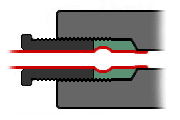| T I G H T E N |
| 3.5 mm 4.5 mm |
| 0.8-0.9 mdaN (8-9 Nm) |
| 6.0 mm |
| 0.9-1.1 mdaN (9-11 Nm) |
|
• ALWAYS wear safety goggles when working on the hydraulic system.
• When you disassemble the hydraulic pipes, put a plug in all the openings, so no impurities can get in.
• The hydraulic pipes must not touch other components, when mounted in the car.
|
|
|
Replacing hydraulic pipes
When you remove hydraulic pipes, always remember to take out the old gasket
and put on a new prior to installation. Easiest way to get out the old one,
is to screw in a body screw and pull/pry gently.
If the gasket don't want to get out, you can try to unscrew the body screw while pulling. The best would be if you had a screw that was links.
If you choose to reuse the old gasket, you must check that it has no faults.
Before assembly:
- Check that the end of the pipe is completely clean and free of paint stains (rinse with cleaning petrol).
- Blow through the pipe with compressed air, both directions.
Assembly:
- Put a little LHM on the gasket.
- Insert the gasket on the end of the pipe in such a way that the tip of the pipe is visible.
- Put the pipe into the connection in a straight line. You may loosen the item the pipe is going into, to make the job easier.
- Tighten with your fingers; help a little with a wrench if necessary. Do not tighten to hard.
- Start the engine and check for leaks. If so tighten some more.
|
|
|
 Gaskets for hydraulic pipes.
Gaskets for hydraulic pipes.
The gaskets are in several sizes, depending on the size of the hydraulic pipes.

|
|

